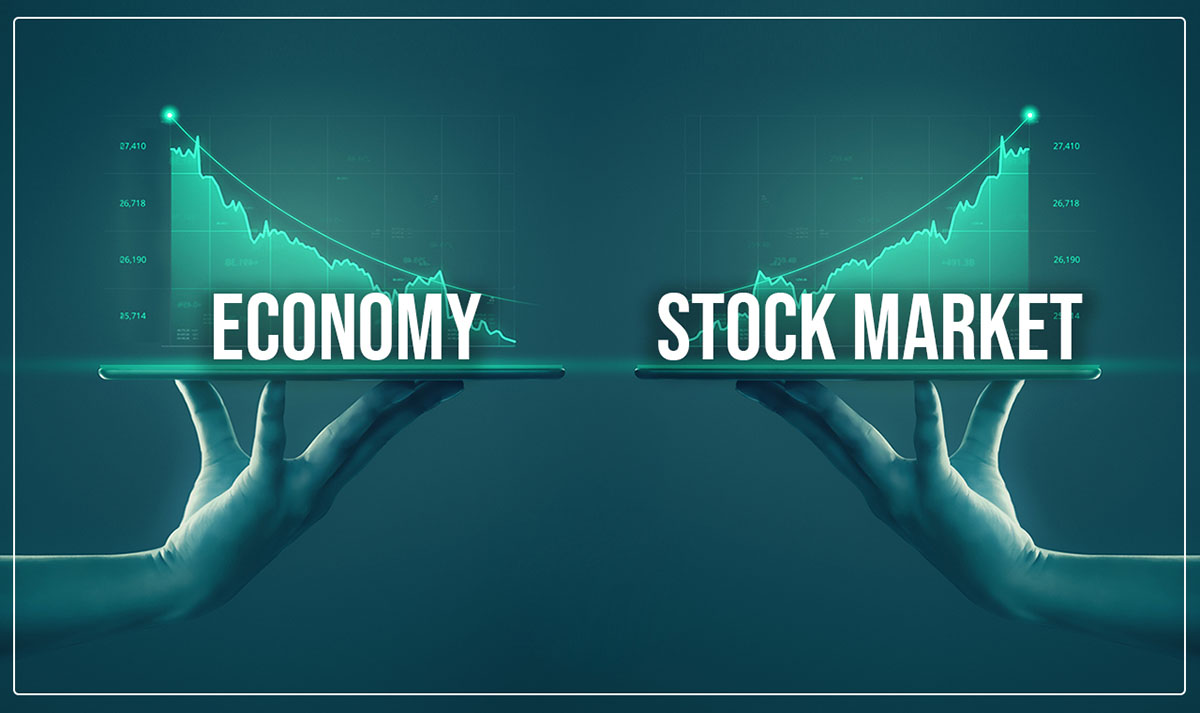

Finance
How Does Student Loans Affect The Economy
Published: January 20, 2024
Discover the impact of student loans on the economy and gain insights into the financial effects. Explore the correlation between finance and student loan burdens.
(Many of the links in this article redirect to a specific reviewed product. Your purchase of these products through affiliate links helps to generate commission for LiveWell, at no extra cost. Learn more)
Table of Contents
- Introduction
- Background of Student Loans
- Impact of Student Loans on Individual Borrowers
- Impact of Student Loans on Household Consumption
- Impact of Student Loans on Homeownership Rates
- Impact of Student Loans on Retirement Savings
- Impact of Student Loans on Small Business Formation
- Impact of Student Loans on Overall Economic Growth
- Policy Recommendations to Address Student Loan Crisis
- Conclusion
Introduction
Student loans have become an increasingly prevalent issue in today’s society. As the cost of higher education continues to rise, many individuals turn to student loans as a means to finance their studies. While student loans can provide access to education for those who may not have the means to pay for it upfront, they also have a considerable impact on the economy as a whole.
In this article, we will explore the various ways in which student loans affect the economy. From the individual borrower to household consumption, homeownership rates, retirement savings, and small business formation – student loans leave a lasting imprint on economic activity at different levels.
The rise in student loan debt is a significant concern for both borrowers and policymakers. According to the Federal Reserve, outstanding student loan debt reached $1.6 trillion in 2020, surpassing credit card and auto loan debt. This unprecedented level of student debt has far-reaching consequences that extend beyond the individuals burdened with repayment.
Moreover, the current economic landscape, characterized by stagnant wages and increasing income inequality, exacerbates the challenges faced by student loan borrowers. As a result, understanding the economic implications of student loans becomes crucial in formulating effective policies and interventions to address the issue.
Throughout this article, we will examine the impact of student loans on individual borrowers and their financial well-being. We will also explore how student loans affect various aspects of the economy, such as household consumption, homeownership rates, retirement savings, and small business formation. Additionally, we will discuss potential policy recommendations to address the student loan crisis and support a healthy and thriving economy.
By delving into these topics, we hope to shed light on the intricate relationship between student loans and the economy. Understanding the effects of student loans on different areas of economic activity is crucial for developing strategies to alleviate the burden on borrowers, promote economic growth, and ensure a sustainable financial future for all.
Background of Student Loans
In the past few decades, the cost of higher education has skyrocketed, outpacing inflation and wage growth. As a result, many students and their families have turned to student loans to bridge the affordability gap and access post-secondary education.
Student loans are financial aid instruments provided by government agencies, private lenders, or educational institutions to help students cover the costs of tuition, fees, books, and living expenses. These loans typically have repayment terms that begin after graduation, with interest accruing during the loan’s lifespan.
The student loan landscape in the United States is mainly divided into two types: federal loans and private loans. Federal loans are administered by the U.S. Department of Education and offer various repayment options, forgiveness programs, and borrower protections. On the other hand, private loans are issued by banks, credit unions, and other financial institutions, often with higher interest rates and fewer borrower benefits.
The expansion of student loan programs has allowed more individuals to pursue higher education, contributing to increased enrollment rates. However, the significant rise in student loan debt has created concerns about its long-term consequences for borrowers and the economy.
According to the Federal Reserve, the average student loan debt per borrower in 2020 was $38,792. High levels of debt can burden borrowers for years, affecting their financial circumstances and potentially hindering their ability to achieve key financial milestones, such as buying a home or saving for retirement.
It’s important to note that student loans are not only obtained by recent high school graduates pursuing a traditional college education. They are also commonly taken out by individuals seeking professional degrees, such as medical or law school, as well as those pursuing technical and vocational training programs.
Furthermore, student loans have often been viewed as a crucial investment in one’s future earning potential. The argument is that a college degree can lead to better job prospects and higher lifetime earnings. However, the reality is that not all borrowers will have the same income trajectory, and the burden of student loan debt can persist even if expected career opportunities don’t materialize.
The student loan crisis has garnered attention from policymakers, economists, and advocacy groups. The rising debt levels and associated economic implications have prompted discussions on potential reforms, such as income-driven repayment plans, loan forgiveness programs, and increased investment in affordable education. Finding a balance between providing access to education and ensuring the economic well-being of borrowers remains a challenge.
In the following sections, we will explore the multifaceted impacts of student loans on the economy, delving into the effects on individual borrowers as well as broader economic indicators. By understanding these dynamics, we can work towards a more sustainable and equitable higher education financing system.
Impact of Student Loans on Individual Borrowers
Student loans have a profound impact on the financial well-being of individual borrowers. While they provide access to education and opportunity, they can also present significant challenges and burdens. Here, we examine some key impacts of student loans on borrowers:
- Debt Burden: Student loans often leave borrowers with a substantial debt burden as they enter the workforce. Monthly loan payments can consume a significant portion of income, making it difficult to meet other financial obligations. This burden can hinder financial stability and limit opportunities for saving and investing.
- Delayed Milestones: The burden of student loans can delay important life milestones. Graduates may postpone buying a home, starting a family, or pursuing advanced degrees or entrepreneurial endeavors due to the financial strain of student loan repayment.
- Career Choices: High student debt can influence career choices. Borrowers may be inclined to prioritize higher-paying jobs over positions aligned with their passions or social impact goals. This can limit career mobility and restrict opportunities in fields that may contribute to the greater good.
- Mental and Emotional Stress: The weight of student loan debt can have a significant toll on mental and emotional well-being. Constantly worrying about repayment and financial stability can lead to stress, anxiety, and a negative impact on overall quality of life.
- Creditworthiness: Student loans play a crucial role in establishing credit history. Responsibly managing student loan repayment can help borrowers build a positive credit history, while missed payments or default can have adverse effects on credit scores, making it more challenging to qualify for other forms of credit, such as mortgages or car loans.
- Opportunity Cost: The financial obligations of student loan repayment often result in opportunity costs. Borrowers may have to forego other investments, such as contributing to retirement savings or pursuing additional educational opportunities, to meet their loan obligations.
It is important to acknowledge the diverse experiences of individual borrowers. While some borrowers may successfully navigate loan repayment and achieve financial stability, others may struggle with the long-term implications of student loan debt. Variances in income, career prospects, and personal circumstances contribute to the varying impacts experienced by borrowers.
Policy interventions, such as income-driven repayment plans and loan forgiveness programs, aim to alleviate the burden on borrowers and promote financial well-being. However, it is crucial to balance providing relief with long-term economic sustainability and fairness for all stakeholders involved.
In the following sections, we will explore how student loan debt extends beyond individual borrowers and affects broader economic areas, including household consumption, homeownership rates, retirement savings, small business formation, and overall economic growth. Understanding these interconnected effects allows us to grasp the full scope of the student loan issue and explore potential solutions.
Impact of Student Loans on Household Consumption
Student loans have a significant impact on household consumption, which plays a crucial role in driving economic growth. The financial burden of student loan debt often limits a borrower’s ability to participate fully in the economy and make substantial consumer purchases. Here are some key ways in which student loans affect household consumption:
- Debt Servicing: Monthly student loan payments consume a substantial portion of a borrower’s income, leaving less disposable income for other expenditures. This can result in reduced spending on goods and services, impacting various sectors of the economy.
- Delayed Major Purchases: The need to allocate a significant portion of income towards student loan repayment can postpone major purchases, such as buying a home or a car, getting married, or starting a family. These delays result in decreased demand for housing, automobiles, and other related industries.
- Impact on Creditworthiness: High levels of student loan debt can affect borrowers’ creditworthiness, making it more challenging to qualify for other forms of credit. Reduced access to credit can restrict the ability to make large purchases, impacting overall consumption patterns and economic activity.
- Reduced Disposable Income: Student debt obligation reduces the disposable income of borrowers, hindering their ability to allocate funds towards discretionary spending, such as entertainment, travel, dining out, and other non-essential expenses. The decrease in discretionary spending has ripple effects on various industries dependent on consumer activity.
- Long-term Financial Planning: The need to prioritize student loan repayment often leads to reduced contributions to retirement savings and other long-term financial goals. This can result in a diminished ability to build wealth and secure financial stability, impacting future consumption patterns in retirement.
The impact on household consumption extends beyond individual borrowers. It affects the overall economy, as decreased consumer spending can dampen economic growth and hinder recovery from recessions or economic downturns. Research suggests that student loan debt results in lower levels of homeownership, decreased housing-related consumption, and reduced mobility across geographic regions, all of which have lasting implications for economic activity.
Addressing the impact of student loans on household consumption requires a comprehensive approach. Policymakers, financial institutions, and educational institutions must work together to develop strategies that alleviate the burden of debt, promote responsible borrowing, and encourage consumer spending. This may include offering more flexible repayment plans, expanding loan forgiveness programs, and implementing policies that increase access to affordable education and reduce the need for excessive student loan borrowing.
By finding ways to mitigate the burden of student loan debt and promote healthier household consumption patterns, we can foster a stronger and more resilient economy.
Impact of Student Loans on Homeownership Rates
Student loans have a significant impact on homeownership rates, a key indicator of a healthy housing market and economic stability. The burden of student loan debt can make it challenging for individuals to save for a down payment, qualify for a mortgage, and afford the ongoing costs of homeownership. Here are some key ways in which student loans affect homeownership rates:
- Reduced Savings for Down Payment: The financial obligations of student loan repayment often leave borrowers with limited funds available for saving towards a down payment on a home. Accumulating enough savings to make a substantial down payment becomes increasingly difficult, potentially delaying or preventing individuals from entering the housing market.
- Higher Debt-to-Income Ratios: Student loan debt impacts the debt-to-income ratios of borrowers, a crucial factor in mortgage qualification. High levels of student loan debt can raise borrowers’ debt-to-income ratios, making it harder to meet lenders’ requirements and qualify for a mortgage.
- Debt-to-Income Thresholds: Lenders typically use certain debt-to-income thresholds to determine borrowers’ eligibility for mortgage loans. Student loan payments are included in this calculation, potentially pushing borrowers above the allowable thresholds and disqualifying them from obtaining a mortgage.
- Decreased Affordability: The financial commitment associated with student loan repayment limits the amount of income available for mortgage payments. This decreased affordability can make it more challenging for individuals to secure a loan or afford a mortgage payment that is within their budget.
- Delayed Entry into the Housing Market: The burden of student loan debt often delays or deters individuals from entering the housing market altogether. This delay results in a decline in the number of first-time homebuyers, which can have long-term implications for the housing market and economic growth.
Research indicates that the impact of student loan debt on homeownership rates is particularly pronounced among young adults. The inability to purchase a home has long-term consequences, as homeownership is often considered a key factor in building wealth and stability.
Addressing the impact of student loans on homeownership rates requires a comprehensive approach. Policies that promote affordable education, provide loan forgiveness or repayment assistance, and improve financial literacy can help alleviate the burden of student loan debt. Additionally, strategies to increase the availability of affordable housing and flexible mortgage options can assist potential buyers in navigating the challenges posed by student loan debt.
By finding solutions that alleviate the obstacles caused by student loans, we can empower individuals to achieve homeownership and contribute to the stability and growth of the housing market and the overall economy.
Impact of Student Loans on Retirement Savings
Student loans not only impact current financial circumstances but also have long-term implications, particularly concerning retirement savings. The burden of student loan debt can hinder the ability of borrowers to save for retirement, potentially leaving them financially vulnerable in their later years. Here are some key ways in which student loans affect retirement savings:
- Delayed Contributions: The monthly student loan payments required of borrowers can limit their ability to contribute to retirement savings accounts, such as 401(k)s or IRAs. The need to allocate a significant portion of income towards loan repayment leaves less available for retirement planning.
- Lost Time and Compound Interest: The longer individuals take to start saving for retirement, the less time they have to benefit from the power of compound interest. Delayed retirement savings due to student loan debt can considerably impact the growth potential of these investments over time.
- Opportunity Costs: The financial obligations associated with student loans often result in opportunity costs, with borrowers having to prioritize loan repayment over retirement savings. The sacrifice of retirement contributions can have long-term consequences, including potential reliance on social welfare programs in later years.
- Reduced Employer Contributions: Many employers offer matching contributions to employees’ retirement accounts. However, if employees are unable to contribute to their retirement plans due to student loan obligations, they may also miss out on these valuable employer match contributions, further diminishing their retirement savings potential.
- Impact on Retirement Lifestyle: Inadequate retirement savings resulting from the burden of student loan debt can lead to a downsized retirement lifestyle. Retirees may struggle to afford basic necessities or engage in meaningful experiences during their retirement years, ultimately impacting their overall quality of life.
The cumulative effect of these factors can leave individuals ill-prepared for retirement, exacerbating existing concerns regarding retirement readiness across the population. The consequences of student loan debt on retirement savings are particularly distressing when viewed in the context of increasing life expectancies, rising healthcare costs, and the uncertain future of social welfare programs.
To address the impact of student loans on retirement savings, a multi-faceted approach is necessary. This includes implementing policies that reduce the burden of student loan debt, improving financial education to encourage responsible borrowing, and promoting increased access to employer-sponsored retirement plans and matching contributions. Additionally, exploring innovative solutions to accelerate student loan repayment or ease the transition from loan repayment to retirement savings can help mitigate the long-term implications on individuals’ financial well-being.
By addressing the challenges posed by student loans and supporting individuals in their retirement savings efforts, we can strive to ensure a more secure and comfortable retirement for all.
Impact of Student Loans on Small Business Formation
The burden of student loans can have a profound impact on small business formation, a vital driver of innovation, job creation, and economic growth. Student loans can hinder aspiring entrepreneurs from starting their own businesses by creating financial constraints and limiting access to resources. Here are several key ways in which student loans affect small business formation:
- Debt-to-Income Ratio: Student loan debt can significantly impact borrowers’ debt-to-income ratios, making it challenging for them to secure financing to start a business. High debt levels can raise red flags for lenders, potentially limiting the availability of capital for entrepreneurial ventures.
- Financial Instability: The monthly student loan payments required can destabilize the financial position of potential business owners. Debt obligations can divert resources that would otherwise be allocated to critical business expenses such as inventory, equipment, and marketing, making it difficult to establish and sustain a small business.
- Limited Access to Capital: The presence of significant student loan debt can reduce an individual’s ability to obtain additional loans or lines of credit. This limited access to capital can severely hinder small business formation, especially when entrepreneurs may already face challenges in securing financing due to the inherent risks associated with starting a new venture.
- Reduced Risk Appetite: The financial uncertainty brought about by student loans can make aspiring entrepreneurs more risk-averse. The fear of failure combined with the burden of debt obligations can discourage individuals from taking the leap into entrepreneurship and choosing more stable, traditional employment.
- Strained Personal Finances: The financial strain of student loan repayment can have a spillover effect on personal finances, leaving individuals with fewer resources to invest in their business ventures. This can limit their ability to hire employees, expand operations, or invest in research and development, all of which are critical for small business growth and success.
The impact of student loans on small business formation is an important consideration, as small businesses play a vital role in job creation and economic vitality. Recent graduates and young professionals are often at the forefront of entrepreneurial activity, and barriers to small business formation can have far-reaching effects on economic growth.
Addressing the impact of student loans on small business formation requires a comprehensive approach. Policymakers can implement measures to alleviate the burden of student loan debt, such as loan forgiveness programs or income-driven repayment options tailored to the unique financial circumstances of entrepreneurs. Providing access to entrepreneurial support networks, mentoring programs, and business incubators can also help create an environment conducive to small business formation and success.
By supporting aspiring entrepreneurs burdened by student loan debt, we can cultivate a thriving ecosystem of small businesses, drive innovation, and stimulate economic growth.
Impact of Student Loans on Overall Economic Growth
The impact of student loans extends beyond individual borrowers and directly influences overall economic growth. The rising levels of student loan debt pose challenges to the broader economy in several ways, affecting productivity, consumption, and long-term economic stability. Here are key ways in which student loans impact overall economic growth:
- Reduced Consumer Spending: The financial burden of student loan repayment limits borrowers’ ability to participate fully in the economy by reducing disposable income available for spending on goods and services. Diminished consumer spending can dampen economic growth, as consumer spending is a significant driver of economic activity.
- Decreased Household Formation: Student loan debt can delay or deter individuals from forming households, such as starting a family or buying a home. The decrease in household formation affects various sectors of the economy, including real estate, construction, and consumer goods, thereby hindering overall economic growth.
- Financial Instability: The burden of student loans can leave borrowers financially vulnerable, impacting their ability to weather economic downturns and contribute to overall economic stability. Financial instability can have negative spillover effects, such as higher rates of loan delinquencies and defaults, creating ripple effects across lending institutions and the broader economy.
- Reduced Entrepreneurship: Student loans can deter aspiring entrepreneurs from starting their own businesses, limiting innovation, job creation, and economic growth. High levels of student loan debt can impede access to capital, increase risk aversion, and jeopardize the financial stability required to take on the risks associated with entrepreneurial ventures.
- Skills Mismatch and Underemployment: The burden of student loan debt may force individuals to prioritize immediate financial stability over pursuing careers aligned with their education and skillset. This can lead to underemployment and skills mismatch, diminishing productivity and hindering economic growth.
- Inter-generational Wealth Transfer: The impact of student loans can reverberate across generations, affecting the inter-generational transfer of wealth. The burden of student loan debt on younger generations can delay wealth accumulation, reduce inheritances, and limit resources available for future investment and economic growth.
Addressing the impact of student loans on overall economic growth requires a holistic approach. Policymakers should focus on developing comprehensive strategies that support responsible borrowing, improve access to affordable education, and implement targeted interventions to alleviate the burden of student loan debt.
Investment in affordable education, student loan debt relief programs, expansion of income-driven repayment plans, and supportive policies for entrepreneurship can help mitigate the adverse effects of student loans on economic growth. By creating an environment that encourages financial stability, innovation, and investment, we can foster robust economic growth that benefits individuals, communities, and the nation as a whole.
Policy Recommendations to Address Student Loan Crisis
The student loan crisis necessitates proactive policy interventions to alleviate the burden on borrowers and create a more sustainable higher education financing system. Here are some key policy recommendations to address the student loan crisis:
- Increased Funding for Grants and Scholarships: Increasing funding for need-based grants and scholarships can help reduce the reliance on student loans, particularly for students from low-income backgrounds. Prioritizing investments in accessible and affordable education ensures that individuals can pursue higher education without incurring excessive debt.
- Expanded Income-Driven Repayment Plans: Expanding and improving income-driven repayment plans can offer relief and flexibility for borrowers struggling with student loan repayment. These plans base monthly payments on borrowers’ income levels, ensuring that payments remain affordable and manageable based on their financial circumstances.
- Loan Forgiveness Programs: Implementing targeted loan forgiveness programs for borrowers who meet specific criteria, such as working in public service or pursuing careers in high-need areas, can incentivize individuals to pursue their desired professions without the fear of overwhelming debt. Such programs can also contribute to addressing societal needs and improving public services.
- Refinancing Options: Creating opportunities for borrowers to refinance their student loans at lower interest rates can help reduce the financial burden and make repayment more manageable. Enabling borrowers to take advantage of lower market interest rates can help alleviate the long-term impact of student loans.
- Increased Financial Literacy: Enhancing financial literacy education can empower individuals to make informed decisions regarding student loans and overall personal finances. Improving awareness of loan terms, repayment options, and responsible borrowing practices can help prevent excessive debt accumulation and equip borrowers with the knowledge they need to manage their loans effectively.
- Investment in Affordable Education: Increasing investment in affordable education, including community colleges and vocational training programs, can provide alternative pathways to higher education that are more cost-effective. Promoting affordable education reduces the need for excessive student loan borrowing and expands access to educational opportunities.
- Better Oversight of For-Profit Institutions: Strengthening regulatory oversight of for-profit educational institutions can protect students from predatory practices and ensure that they receive valuable education that aligns with their career aspirations. Implementing stricter accountability measures can help curb the accumulation of student loan debt from institutions with poor outcomes.
- Expanded Employer Contributions: Encouraging employers to offer student loan repayment assistance or expanding employer match contributions for retirement savings to include student loan payments can alleviate the financial burden for borrowers. This can enhance employee benefits and aid in retaining a skilled workforce.
Implementing these policy recommendations requires a collaborative effort between policymakers, educational institutions, financial institutions, and other stakeholders. By combining these strategies, we can work towards a more equitable and sustainable student loan system that empowers individuals to pursue education while minimizing the burden of debt.
However, it is important to note that any policy changes should strike a balance between borrower relief and long-term economic sustainability, ensuring fairness for all stakeholders. Continued research, evaluation, and adaptability are crucial to develop effective solutions to address the student loan crisis and support individuals in their pursuit of higher education and long-term financial success.
Conclusion
The impact of student loans on individuals and the economy at large is undeniable. As the cost of higher education continues to rise, student loans have become a necessary means for many to access educational opportunities. However, the burden of student loan debt poses significant challenges and has far-reaching implications for borrowers and the overall economy.
Throughout this article, we have explored the multifaceted impacts of student loans. From the individual borrower struggling with debt repayment to the broader economic indicators of household consumption, homeownership rates, retirement savings, small business formation, and overall economic growth, it is clear that student loans shape the trajectory of individuals’ lives and the health of the economy.
Policy interventions are necessary to address the student loan crisis. By investing in affordable education, expanding loan forgiveness programs, improving income-driven repayment options, and increasing financial literacy, we can alleviate the burden on borrowers and create a more equitable higher education financing system.
It is essential to strike a balance between providing relief for borrowers and ensuring long-term economic sustainability. By implementing targeted policies that address the challenges posed by student loans, we can foster economic growth, innovation, and financial well-being for individuals and society as a whole.
Addressing the student loan crisis requires collaboration and a shared commitment from policymakers, educational institutions, financial institutions, and other stakeholders. By working together, we can create a future where individuals have access to quality education without the overwhelming burden of student loan debt.
Ultimately, solving the student loan crisis is an investment in the success and prosperity of individuals and the broader economy. By implementing thoughtful policies and interventions, we can pave the way for a more secure, equitable, and thriving society.














